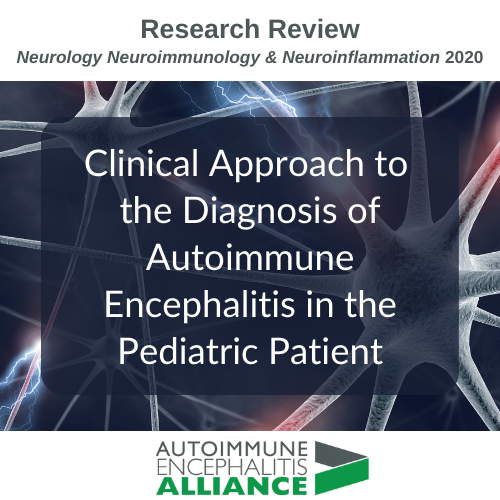Clinical Approach To The Diagnosis Of Autoimmune Encephalitis In The Pediatric Patient
June 20, 2023

We were recently asked to post and comment on the proposed pediatric autoimmune encephalitis (AE) classification criteria published in 2020. The pediatric criteria followed much of the framework of the adult criteria, but highlighted important difference between pediatric and adult presentations. In addition, the pediatric criteria started from the point of the initial assessment, with the hope of providing some guidance on who should undergo the invasive and expensive evaluation for AE in the first place.
As a result, the initial step on the criteria is “possible pediatric AE”, which is not a diagnostic category itself, but rather the starting point to define which children may benefit from an AE evaluation. The label is given to define children presenting with the onset, signs and symptoms classic for AE (referred to as “clinical evidence of neurologic dysfunction” in the paper), for which an evaluation should be done. Given most children with new onset seizures, tics, behavior changes, or psychiatric symptoms will not need an evaluation for AE, as there are much more common conditions that explain these symptoms, the goal of the “possible pediatric AE” category is to help providers decide who should undergo the testing for AE. To make a diagnosis of AE, the following testing is required: MRI with and without contrast, lumbar puncture, extensive blood work, and in some cases EEG and neuropsychiatric testing). It is critical to recognize you cannot have a diagnosis of AE without having this work up, as the diagnostic criteria to have AE require positive test results.
This is one of the most commonly misunderstood aspects of this criteria, as some confuse the “possible pediatric AE” label as a diagnosis of AE, confusing it with “seronegative AE”. This manuscript clarifies this in the section “If a patient fulfills criteria for possible pediatric AE (table 4) and is functionally impaired, therapy may be started while awaiting the results of antibody and other testing, given the importance of early treatment to improve outcomes.4,25,26 If a patient with possible AE subsequently does not have positive antibodies or paraclinical testing for neuroinflammation, a diagnosis of AE is not supported. For these children, careful further consideration of the differential diagnosis is warranted, and additional immune therapy should only be undertaken with caution”. Sero-negative AE, defined as “probable antibody negative AE” in this paper, requires signs of inflammation as defined by: >1 of a. CSF white blood cell count >5 or oligoclonal bands b. MRI features of encephalitis c. brain biopsy showing inflammation). To have a diagnosis of “definite antibody positive AE”, the child has to have an anti-neuronal antibody (NMDA and GAD should be present in CSF to be considered positive for AE).
This paper was the initial attempt to define pediatric AE and to help differentiate it from other conditions that can be associated with acute onset neurologic or psychiatric symptoms, with other conditions such as central nervous system vasculitis, febrile infection-related epilepsy syndrome (FIRES) and PANS/PANDAS being included as other conditions to consider if the workup is negative for AE.
Thank you to Heather Van Mater, MD, a member of the AEA Medical Advisory Board for providing this Research Review.